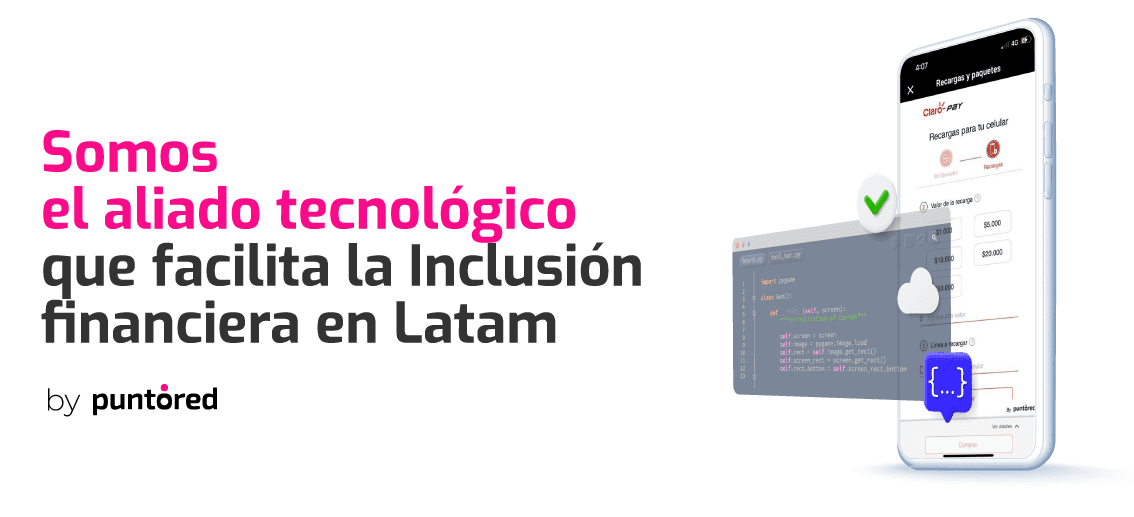Banking as a Service has become popular in recent years. It refers to the possibility for financial institutions to «rent» some of their assets (information, technology, infrastructure, licenses, data, etc.) for third parties to use as part of their value offering.
As can be imagined, many financial institutions do not like this model because they can, in a way, cannibalize their own products with more competition. However, in an increasingly interconnected world with diverse user needs, these alliances are more common and important than we can imagine. We find cases such as Puntored that uses connections with banks to offer money transfer services, or, a popular digital wallet in Colombia that, through an alliance with Davivienda, complements its capabilities by providing financial services to its users (e.g. issuing a Debit Card with its own brand).
To have a better understanding of the types of services in Banking as a Service, it´s useful to group them into the following categories:
- Financial Data of individuals and companies: promoted by Open Banking (a regulatory change that facilitates the opening of banking information), in which financial institutions allow third parties to access customer data from banks or other financial institutions. Developing services around this data, such as Identity Validation or Credit Scoring, is a form of Open Banking.
- Money Transfers: Once banks allow access to Data from their customers’ accounts, the next step is to allow changes in such information. In other words, to make debit and credit movements in the accounts. This transaction can be used to develop services such as immediate transfers or to facilitate instant disbursements from Digital Credit companies, directly into the customer’s bank account.
- Debit or Credit Infrastructure: is understood as the facility provided by a bank for a third party to act as a provider of a financial service, using the entity’s license of capture or issuance. An example of this is a company that issues debit cards or Puntopay, a Merchant Aggregator that operates under Davivienda’s acquiring licenses.
Open Banking and Banking as a Service create a more dynamic and inclusive financial sector allowing our country to advance in key public policy issues such as: the formalization of small commerce, the elimination of cash and greater rural inclusion to financial services. This would result in greater growth and tax collection from a larger base of users. These objectives, now more than ever, are key to post-pandemic recovery.
However, we currently have major barriers that prevent banks and other financial institutions from decisively approaching these business models. The first obstacle has to do with technology.
The challenge of migrating from Legacy Systems, as are most of the Core Banking in our country, which do not allow to easily develop communication protocols with third parties known as APIs. Entities have enough technological challenges with the evolution of their own products to dedicate time to connect with third parties. This is the main barrier for some services, such as enabling immediate transfers.
Another type of barrier is the lack of clarity in regulation or adequate market conditions that guarantee banks’ bets to work in alliance with Fintechs. Innovation is usually a few steps ahead of regulation, and making decisions without a clear picture is difficult for a regulated industry such as finance. In 2020 the Colombian government had milestones closing the gap between regulation and market opportunities. However, this must be accompanied by the timely issuance of decrees that deepen some aspects of the relationship between banks and third parties. At present, and simultaneously with the writing of this article, key efforts are being articulated to enable Open Banking in Colombia, generating a framework of understanding to a large part of these relationships with third parties.
Finally, there are barriers derived from market conditions that do not encourage competition. To avoid this, the government must ensure that the financial services market is not influenced by laws that generate regulatory or fiscal arbitrage in favor of a specific business model. This arbitration is especially dangerous when it rewards closed ecosystems that do not encourage competition, since in the end the main loser due to cost overruns or lack of access is the ordinary consumer.
In the world exists several examples of closed ecosystems that end up concentrating a disproportionate amount of power in a few players. A clear example is the closed QR payment model in China, which grew exponentially due to embedded costs that made it impossible for others to compete. This situation ended up excessively concentrating the business in players such as AliPay, which generated concern in the governments of both hemispheres, to the point of stopping one of the most talked-about IPOs in history and accelerated an abrupt intervention by the Chinese government, the outcome of which is still unknown.
For instance,, another example is Colombia. One of the countries in the region with less acceptance of low value digital payments: several studies suggest this is due to the high costs for merchants,mainly from withholding taxes and the 4×1000.
In Colombia, few financial institutions have managed to overcome these barriers. Some have the economic or political commitment, but do not have the technology, and vice versa.
That is why we are seeing how some Fintechs, which have developed interconnection capabilities with financial institutions over the years, are becoming great allies of financial institutions and third parties that are interested in developing joint models but lack technological competencies or find it difficult to achieve scalable business models. These types of services could be called Fintech as a Service; companies that help banks enter the world of products as a service.
These Fintechs, which are not limited to one or more financial services, offer the ability to add services from other sectors such as insurance, telecommunications, content, among other added values, such as loyalty programs and benefit plans. They also allow the aggregation of data from various sectors, combining financial information with relevant data on customer consumption in the real sector.




